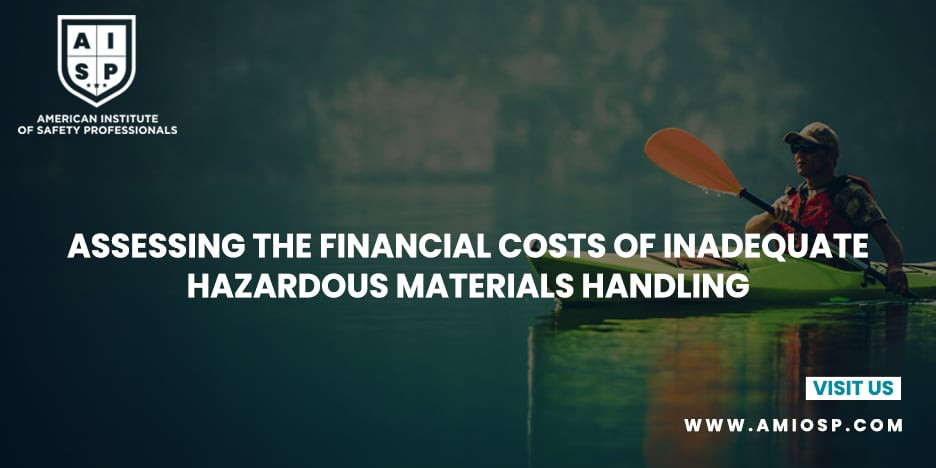Inadequate handling of hazardous materials can result in
significant financial costs for organizations. The improper management of these
materials can lead to accidents, environmental damage, legal liabilities, and
reputational harm. In this blog post, we will explore the financial costs
associated with inadequate hazardous materials handling and highlight the
importance of implementing proper protocols and best practices.
1. Introduction: Understanding the Consequences of
Inadequate Handling
Inadequate handling of hazardous materials poses various
risks and can result in severe consequences. These consequences can have a
direct impact on an organization's financial health. Understanding the
potential financial costs associated with inadequate handling is crucial for
organizations to recognize the importance of proper protocols and invest in
robust hazardous materials management practices.
2. Direct Costs of Accidents and Incidents
Accidents and incidents involving hazardous materials can
result in significant direct costs for organizations. These costs may include:
- Cleanup
and Remediation: Spills, leaks, or releases of hazardous materials
require immediate cleanup and remediation efforts. These activities can be
expensive, involving specialized equipment, materials, and trained
personnel.
- Property
Damage: Accidents involving hazardous materials can cause damage to
equipment, infrastructure, and property. Repairing or replacing damaged
assets can be a substantial financial burden for organizations.
- Injuries
and Medical Costs: Accidental exposure to hazardous materials can
result in injuries to workers or individuals in the surrounding area.
Medical costs, including emergency treatment, hospitalization, and
long-term care, can be significant.
- Legal
and Regulatory Penalties: Non-compliance with hazardous materials
handling regulations can lead to legal penalties, fines, and sanctions
imposed by regulatory authorities. These costs can vary depending on the
severity of the violations and the jurisdiction in which the organization
operates.
3. Indirect Costs and Reputational Damage
Inadequate handling of hazardous materials can also have
indirect financial costs and cause reputational harm to organizations. These
costs may include:
- Business
Interruption: Accidents or incidents involving hazardous materials can
disrupt business operations, leading to production delays, downtime, and
revenue loss. Organizations may also face additional costs associated with
temporary shutdowns, rescheduling, and lost productivity.
- Environmental
Remediation: Accidental releases of hazardous materials can result in
environmental contamination, requiring extensive remediation efforts.
Organizations may be responsible for cleanup costs, restoration of
affected ecosystems, and compensation for environmental damage.
- Legal
Claims and Lawsuits: Injuries, illnesses, or property damage resulting
from inadequate hazardous materials handling can lead to legal claims and
lawsuits. Organizations may face legal fees, settlements, or judgments,
adding significant financial strain.
- Reputational
Damage: Accidents involving hazardous materials can tarnish an
organization's reputation and erode public trust. This can lead to decreased
customer loyalty, loss of business opportunities, and a negative impact on
the organization's brand value.
4. Insurance Costs and Premiums
Inadequate hazardous materials handling can also impact
insurance costs and premiums. Insurers consider the level of risk associated
with an organization's operations, including the management of hazardous
materials, when determining insurance coverage and premiums. Organizations with
poor handling practices or a history of accidents may face higher insurance costs,
reducing their financial resources for other critical areas of the business.
5. Importance of Proper Handling Practices and Risk
Mitigation
To minimize the financial costs associated with inadequate
hazardous materials handling, organizations must prioritize proper handling
practices and risk mitigation strategies. Key steps include:
- Compliance
with Regulations: Organizations should stay up to date with applicable
regulations and ensure compliance with hazardous materials handling
requirements. This includes obtaining necessary permits, implementing
proper storage and handling protocols, and providing adequate training to
employees.
- Risk
Assessment and Management: Conduct thorough risk assessments to
identify potential hazards and implement appropriate risk management
strategies. This may include the use of engineering controls, containment
measures, and emergency response plans.
- Employee
Training and Education: Providing comprehensive training and education
programs to employees involved in hazardous materials handling. Ensuring
that employees understand proper handling procedures, safety protocols,
and emergency response actions can significantly reduce the risk of
accidents.
- Continuous
Improvement and Auditing: Regularly reviewing and improving hazardous
materials handling practices through audits and evaluations. This allows
organizations to identify areas for improvement, address potential
weaknesses, and stay proactive in managing risks.
6. Conclusion: Mitigating Financial Risks through
Adequate Handling
The financial costs of inadequate hazardous materials
handling can be substantial and have a lasting impact on organizations. By
recognizing the potential financial risks associated with inadequate handling
practices, organizations can prioritize the implementation of proper protocols,
invest in training and education, and continuously improve their hazardous
materials management strategies. By doing so, organizations can minimize the
financial burden of accidents, protect their reputation, and ensure the safety
of their employees, the environment, and the communities in which they operate.












0 comments
No Comments